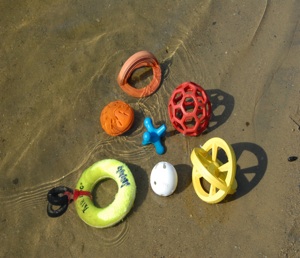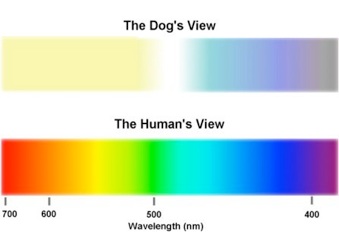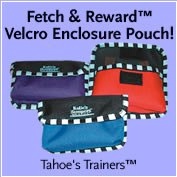Submersion Articles

Most of the hard rubber toys in any pet store sink and others can be weighted with the ring weights found in stores selling golf club equipment. Whiffle balls are fun underwater toys too, just add a few drill holes, push in some pebbles or marbles and the rattling ball sinks fast. The CWS Treat Pouch (listed below) also sinks and when filled with treats it creates a hard to beat incentive for getting the dive behavior started.
Consider, size, color and height when training in natural water environments which may have dark, mucky bottoms and loose debris that could cloud visibility for dives. To avoid teaching your dog that she can paw up or paw the article to shore, begin submersion training in a pool where you can hold the article suspended in K9 elbow deep water or place it on a submerged platform at a distance from shore that eliminates a shallow path to the shoreline.
HOW CANINE COLOR VISION EFFECTS RETRIEVE WORK

This chart represents the color range scientists believe dogs can see. While dogs may not see reds and greens the way we do, their perception of contrasting colors between the environment and the retrieve article does make visual targeting by color possible. Canine visual acuity (sharpness) and brightness discrimination (between shades of gray) is believed to be far less than humans. However, dogs have better peripheral and night vision that us. While size & shape contrast may play a role in some water retrieves, scent and movement seem to play the greatest role in article detection for dogs. Color can help handler’s better locate and direct dogs to articles and there may be another color factor trainers may want to consider for retrievers. CWS trainers have noticed that some dogs tend to be significantly aroused by neon colors (vibrancy discrimination).
When planning your training session choose colors for retrieve articles that will create a color contrast or the opposite, a blending with the background environment, to best achieve your training objective. A yellow ball dropped into tall grass tends to blend with the environment, which is great for directed, blind and scent retrieve training. However, this same yellow ball will pop in color contrast on a lake or river, which may aid in visual targeting. But, don’t forget the other factors that effect you dog’s ability to locate the article: size, shape, pattern, movement, and scent.








